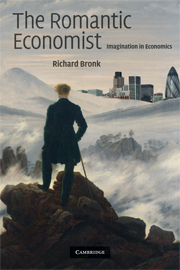Book contents
- Frontmatter
- Dedication
- Epigraph
- Contents
- Preface
- Acknowledgements
- 1 Preface to The Romantic Economist
- PART I THE PRELUDE: THE ROMANTIC ECONOMIST AND THE HISTORY OF IDEAS
- 2 The great divide
- 3 Debates within political economy
- 4 Lessons from Romanticism
- PART II Fragments of Unity: Romantic Economics in Practice
- Notes
- Bibliography
- Index
3 - Debates within political economy
Published online by Cambridge University Press: 05 March 2015
- Frontmatter
- Dedication
- Epigraph
- Contents
- Preface
- Acknowledgements
- 1 Preface to The Romantic Economist
- PART I THE PRELUDE: THE ROMANTIC ECONOMIST AND THE HISTORY OF IDEAS
- 2 The great divide
- 3 Debates within political economy
- 4 Lessons from Romanticism
- PART II Fragments of Unity: Romantic Economics in Practice
- Notes
- Bibliography
- Index
Summary
The fashion for a simplified dialectical representation of the history of ideas and contemporary culture has waned somewhat since the 1950s when F. R. Leavis, C. P. Snow and others followed the lead of J. S. Mill and nineteenth-century German philosophy. Nevertheless, there is plenty of evidence to suggest that in many important respects the modern outlook is still riven by a cultural and intellectual schism between Romanticism and most scientific versions of rationalism. There remains an important dissonance between visions structured according to organic metaphors and those structured by mechanical metaphors; there remains an unresolved tension between models of human motivation that stress the role of sentiment and self-creation and those that reduce it to the constrained but rational optimization of preferences; and there remains a disjunction between the claims of art and imagination, on the one hand, and formal scientific methods and calculating reason, on the other. It is a key premiss of this book that this great cultural and intellectual divide has impoverished the science of economics by depriving it of full access to the most important lessons of Romanticism, despite the bridge-building efforts of Mill and others. Nevertheless, as this chapter should make clear, it would be quite wrong to underestimate either the range of debate within the emerging discipline of economics over the last two hundred and fifty years or the extent to which it has already taken on board at least some aspects of the Romantic critique of rationalism.
- Type
- Chapter
- Information
- The Romantic EconomistImagination in Economics, pp. 57 - 83Publisher: Cambridge University PressPrint publication year: 2009

